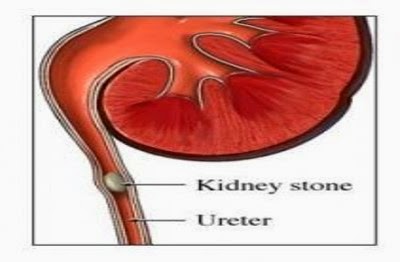How does fluorescence cytology work?
HAL is preferentially absorbed by cancer-cells than normal urothelial (lining) cells of the bladder. A sufficient amount of HAL is absorbed in about an hour. When exposed to "blue-light illumination" the HAL is visibly seen as a bright, fluorescent lesion. More details can be found at the Cysview website.Practically, the HAL solution is instilled into the bladder via a urethral catheter at least 1 hour prior to surgery. In the operating room, the urologist can perform both standard, "white light" cystoscopy and "blue light" cystoscopy in the examination of the bladder.
 |
| An ideal case from the Cysview.com Clinical Library Atlas: http://www.cysview.com/clinical-library/atlas/ |
What is the key evidence that HAL (Cysview) works?
Stenzl et al. Hexaminolevulinate Guided Fluorescence Cystoscopy Reduces Recurrence in Patients with Nonmuscle Invasive Bladder Cancer. J. Urol. 2010
In this prospective, randomized study, 814 patients with suspected Ta/T1 disease on outpatient cystoscopy were divided into groups receiving standard white light cystoscopy versus HAL (Cysview) based cystoscopy. 280 patients in the white light cystoscopy group and 271 in the fluoresce cystoscopy group were followed with cystoscopy for 3, 6, and 9 months following initial resection or until recurrence. This study demonstrated that HAL (Cysview) improved detection of Ta or T1 tumors in 16% of patients, and improved identification of CIS in 32% of patients whose cancer was not detected with white light. Several patients in the study had Ta lesions identified with white light and concurrent CIS detected only with HAL (Cysview), an important finding given the divergent treatment paradigms for Ta and CIS lesions.Grossman et al. Long-term reduction in bladder cancer recurrence with hexaminolevulinate enabled fluorescence cystoscopy J. Urol. 2012
In this long term follow up of the study described above, the authors found that median recurrence free survival was 9.6 months in the white light group and 16.4 months in the HAL (Cysview) group. With a median follow up of 55 months and low overall numbers of patients with disease progression, there was no statistical difference between rates of upstaging (T2-4 disease) or cystectomy. However, the white light group had double the patients with upstaging and cystectomy, and as follow up is extended in the future these results may prove significant.Burger et al. Photodynamic Diagnosis of Non-muscle-invasive Bladder Cancer with hexaminolevulinate Cystoscopy: A Meta-analysis of Detection and Recurrence Based on Raw Data. Eur Urol 2013.
In this metanalysis of 9 studies, the authors demonstrated that HAL (Cysview) detected 14.7% more Ta bladder tumors and 40.8% more CIS lesions. Similarly, recurrence rates at 12 months in the pooled dataset were 35% in the HAL (Cysview) group versus 45% in the white light groupWhat are the barriers to HAL (Cysview) implementation?
Currently, the use of HAL (Cysview) can only be undertaken when partnered with the Karl Storz D-light system and not with other manufacturers. Though likely temporary, this constitutes a market inefficiency and a barrier to widespread adoptionWhat are the remaining questions with HAL (Cysview)?
It is clear that HAL (Cysview) accurately detects bladder cancer. It is not clear exactly how much, if at all, "blue light" cystoscopy is better than standard, "white-light" cystoscopy. A number of important questions remain:- Will HAL (Cysview) eliminate the need for a “2nd look” TURBT? Currently, even in the best of hands, standard, "white light" cystoscopy and TURBT leaves cancer behind or misses muscle-invasion in 10-20% of patients. Therefore, standard practice and the AUA (American Urological Assocation) Guidelines recommend a 2nd procedure to ensure all cancer has been resected. It is not yet known if HAL (Cysview) can improve outcomes of primary TURBT and alleviate the need for a 2nd look TURBT.
- Does HAL (Cysview) detect clinically-significant cancers (i.e. cancers that will change management)? From the evidence in the studies above, we know that blue light cystoscopy will find more cancers than white light cystoscopy. However, many of these cancers a non-invasive cancers and similar to other, known lesions in the same patient. In some patients HAL (Cysview) can certainly make a difference - it is not clear who these patients are.
- Will HAL (Cysview) ultimately lead to increased bladder preservation due to more complete and earlier resections? This will likely be answered with greater follow up in the next few years as earlier randomized studies mature.
HAL (Cysview) is an emerging technology with the potential to change the way bladder cancer in managed. As clinical experience and knowledge is gained regarding its use and patient outcomes, its role will be more clearly defined. If suspicious of a bladder cancer, or there is a history of or known cancer, feel free to talk to your urologist about HAL (Cysview) and blue light cystoscopy. However, HAL (Cysview) and blue light cystoscopy may not be of benefit and therefore, is not for every patient.

This blog was written by Max Kates, MD, a URO-2 resident at the Brady Urological Institute at Johns Hopkins.



























